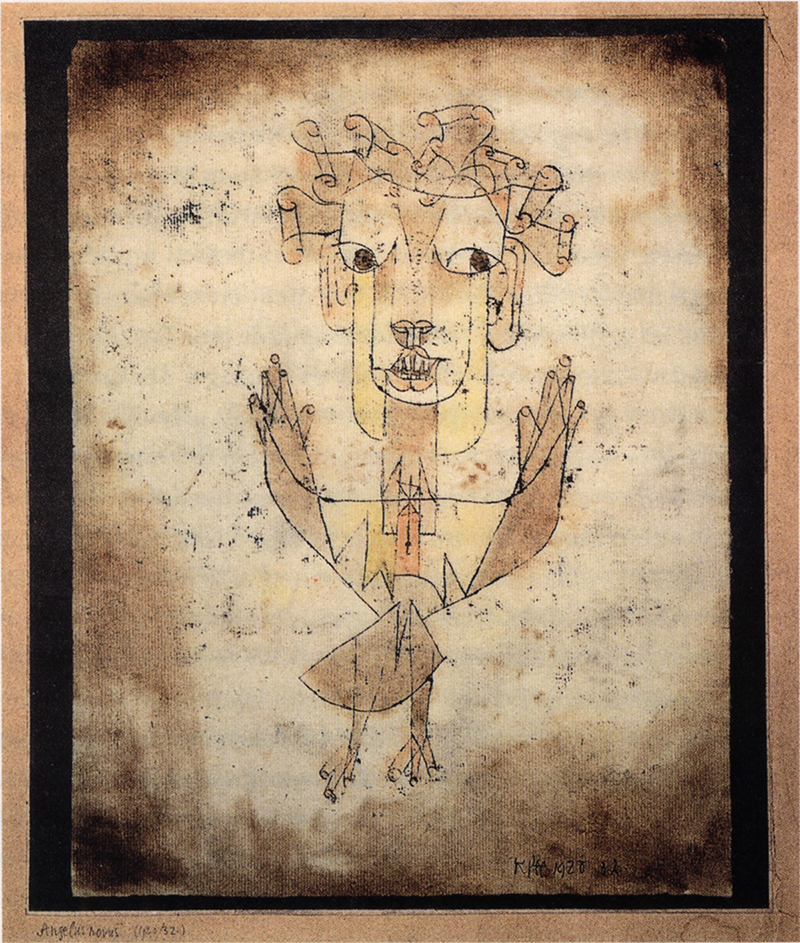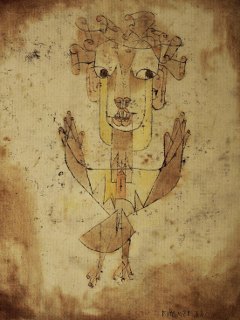Angelus Novus expresses Klee's inner demons and fears during a difficult time in his life
The Angelus Novus by Paul Klee is a monoprint, showing "an angel, contemplated and fixated on an object, slowly moving away from it", according to the purchaser of the piece of art, German philosopher Walter Benjamin.
It was Benjamin's views on the artwork which made in particularly famous, but we was not the only owner of it. He bought it from Klee in 1921 before later being passed on to his close associates, Theodor W. Adorno and then later Gershom Scholem (a poem of which he wrote about the artwork is included further down the page).
According to several experts and philosophers, Paul Klee painted what is imagined to be the Angel of History by many. Klee was conscripted into the the German forces during World War One and was deeply affected by this.
Klee's method of painting the Angelus Novus was actually invented by the man himself. His oil transfer technique (monoprint) involved covering a piece of tracing paper with ink, then placing drawing paper underneath and scratching the top paper with a needle or another sharp object in order to to make a copy on the one below.
Angelus Novus shows an apparently aghast angel, eyes glued to an image of despair, stuck in a flying motion neither going forwards nor backwards. Not many paintings likes this one can be seen in the world, due to Klee's inventive new technique and also due to the topic of which Paul created his work.
According to Walter Benjamin, whilst fleeing the Nazis in 1940: "... A Klee painting named Angelus Novus shows an angel looking as though he is about to move away from something he is fixedly contemplating. His eyes are staring, his mouth is open, his wings are spread...
"...This is how the angel of music must look. His face is turned to the past... he sees one single catastrophe, which keeps piling up wreckage upon wreckage... He would like to... make whole what has been smashed...
...A storm is blowing from Paradise; it has got caught in his wings with such violence the angel can no longer close them. This storm irresistibly propels him into the future to which his back is turned, while the pile of debris before him grows skyward. This storm is what we call progress..."
Walter Benjamin and Klee's Angelus Novus (New Angel)
For German philosopher Walter Benjamin, it was believed to be his most prized possession. Purchased for 1,000 marks in Munich, 1921, this was an original artwork of transfer drawing with watercolour.
Benjamin's friend, Charlotte Wolf, would later reveal how excited he was to get hold of this piece which was to inspire him, and many others besides. In fact it would remain significant in his life until his death in 1940.
The new owner would move it from home to home in order to keep it as a constant source of inspiration. It's ongoing presence in his life signified again the fondness that he felt for it.
Benjamin would draw some connections with his Jewish faith, though these were unlikely to have been in Klee's mind at the time as he was not Jewish himself.
Paul Klee's art style was, in part, expressionist, a style which in it's simplicity portrays significant meaning. Pierrot Lunaire is arguably the most alike to the Angelus Novus. Another painter who gained a lot of fame for his expressionist style is Edvard Munch, who created the extremely famous painting The Scream.
Klee would himself cover many other art movements during his career besides just expressionism - such as cubism, futurism and also more traditional styles during his early development.
American artist R. H. Quaytman revealed through research that the original monoprint had been administered on an 1838 copper-plate engraving by Friedrich Muller after a Lucas Cranach portrait piece.
Whilst being an original piece, both in the meaning of the work and the way in which it was constructed, it was not unusual for an artist to theme a work around depression, or as it was more often referred to then, melancholy. Besides Munch's The Scream, there was also a much earlier example in Albrecht Durer's Melencholia I.

A Theory giving an Alternative Meaning to the Artwork
Some recent researchers have placed Adolf Hitler as the portrait of Angelus Novus, rather than the Angel of History as many have always argued. The 2008 exhibition at the Neue National Galerie in Berlin, for example, gave greatest prominence to this artwork and boldly put out this theory to its passionate visitors.
Further researchers and theorists, some from Stanford University, have provided evidence to support their claims, but most still pursue the original explanation.
Poem dedicated to Angelus Novus by Gershom Scholem
The poem was written for Benjamin's 29th birthday on July 15, 1921. It is taken from the translated version of The Fullness of Time: Poems.
My wing is poised to beat
Gershom Scholem, "Greetings from Angelus" (translation by Richard Sieburth)
but I would gladly return home
were I to stay to the end of days
I would still be this forlorn
Sculpture inspired by Angelus Novus
The Israel Museum collection also contains a sculpture by Anselm Kiefer which was inspired by Klee's mystical oil transfer with watercolour artwork.
Said sculpture was entitled Angel of History: Poppy and Memory, and was produced in 1989.
Current Ownership
After passing ownership several times, normally through inheritance or gifting rather than private purchase, the original Angelus Novus is now on display at the Israel Museum in Jerusalem.
They have classified it under accession number B87.0994 and list it as a public domain item received from Fania & Gershom Scholem, Jerusalem; John, Marlene & Paul Herring, Jo Carole & Ronald Lauder, New York.




